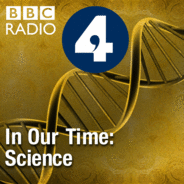Melvyn Bragg and guests discuss the work and ideas of Dorothy Crowfoot Hodgkin (1910-1994), awarded the Nobel Prize in Chemistry in 1964 for revealing the structures of vitamin B12 and penicillin and who later determined the structure of insulin. She was one of the pioneers of X-ray crystallography and described by a colleague as 'a crystallographers' crystallographer'. She remains the only British woman to have won a Nobel in science, yet rejected the idea that she was a role model for other women, or that her career was held back because she was a woman. She was also the first woman since Florence Nightingale to receive the Order of Merit, and was given the Lenin Peace Prize in recognition of her efforts to bring together scientists from the East and West in pursuit of nuclear disarmament.With Georgina Ferry
Science writer and biographer of Dorothy HodgkinJudith Howard
Professor of Chemistry at Durham UniversityandPatricia Fara
Fellow of Clare College, CambridgeProducer: Simon Tillotson

Wissenschaft & Technik
In Our Time: Science Folgen
Scientific principles, theory, and the role of key figures in the advancement of science.
Folgen von In Our Time: Science
284 Folgen
-
Folge vom 03.10.2019Dorothy Hodgkin
-
Folge vom 23.05.2019Kinetic TheoryMelvyn Bragg and guests discuss how scientists sought to understand the properties of gases and the relationship between pressure and volume, and what that search unlocked. Newton theorised that there were static particles in gases that pushed against each other all the harder when volume decreased, hence the increase in pressure. Those who argued that molecules moved, and hit each other, were discredited until James Maxwell and Ludwig Boltzmann used statistics to support this kinetic theory. Ideas about atoms developed in tandem with this, and it came as a surprise to scientists in C20th that the molecules underpinning the theory actually existed and were not simply thought experiments. The image above is of Ludwig Boltzmann from a lithograph by Rudolf Fenzl, 1898With Steven Bramwell Professor of Physics at University College LondonIsobel Falconer Reader in History of Mathematics at the University of St Andrewsand Ted Forgan Emeritus Professor of Physics at the University of BirminghamProducer: Simon Tillotson
-
Folge vom 11.04.2019The Evolution of TeethMelvyn Bragg and guests discuss theories about the origins of teeth in vertebrates, and what we can learn from sharks in particular and their ancestors. Great white sharks can produce up to 100,000 teeth in their lifetimes. For humans, it is closer to a mere 50 and most of those have to last from childhood. Looking back half a billion years, though, the ancestors of sharks and humans had no teeth in their mouths at all, nor jaws. They were armoured fish, sucking in their food. The theory is that either their tooth-like scales began to appear in mouths as teeth, or some of their taste buds became harder. If we knew more about that, and why sharks can regenerate their teeth, then we might learn how humans could grow new teeth in later lives. With Gareth Fraser Assistant Professor in Biology at the University of FloridaZerina Johanson Merit Researcher in the Department of Earth Sciences at the Natural History Museumand Philip Donoghue Professor of Palaeobiology at the University of BristolProducer: Simon Tillotson
-
Folge vom 21.02.2019PheromonesMelvyn Bragg and guests discuss how members of the same species send each other invisible chemical signals to influence the way they behave. Pheromones are used by species across the animal kingdom in a variety of ways, such as laying trails to be followed, to raise the alarm, to scatter from predators, to signal dominance and to enhance attractiveness and, in honey bees, even direct development into queen or worker. The image above is of male and female ladybirds that have clustered together in response to pheromones. With Tristram Wyatt Senior Research Fellow at the Department of Zoology at the University of OxfordJane Hurst William Prescott Professor of Animal Science at the University of Liverpooland Francis Ratnieks Professor of Apiculture and Head of the Laboratory of Apiculture and Social Insects at the University of SussexProducer: Simon Tillotson
